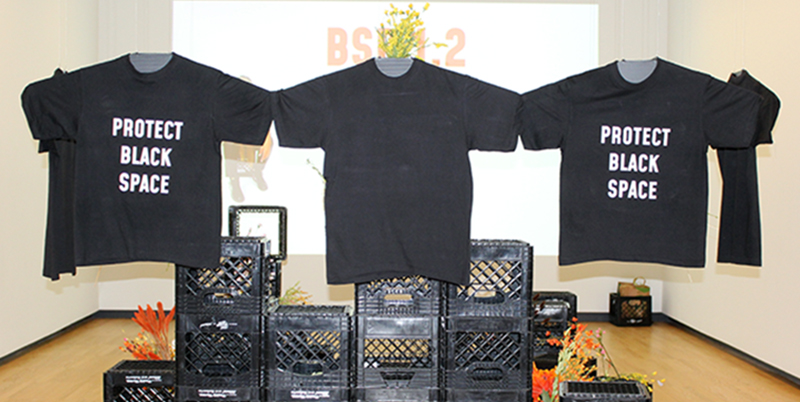Ever since its September opening at Krannert Art Museum, I have been sitting with my experiences of Black on Black on Black on Black, imagining what I would say in this space. Some of that time has been spent physically sitting within its thoughtfully curated installations. But quite often, as I go through my day, a certain song, a certain light, a certain feel of a well-loved wooden chair, takes me back to its galleries, and beyond. I remember how during the opening weekend panel discussion on the KAM lawn, faculty artist and designer Nekita Thomas shared how the milk crate, magical in its endless capacity for transformation, became a central image in her installation.The litany of remembered milk crate metamorphoses (record collection container, table, chair) had many Black audience members nodding and laughing in recognition of shared memories. When I found myself nodding along, I began to consider this: As a white person whose childhood memories include time spent in Black spaces, these are my memories, my experiences of being invited in, but as vivid and visceral as they are, they in no way provide a claim to those spaces. As with the spaces within Black on Black on Black on Black, I can only appreciate what was shared and taught and carry that with me as a seed for understanding and allyship.
Black on Black on Black on Black is a collaboration between Patrick Earl Hammie, Stacey Robinson, Blair Ebony Smith, and Nekita Thomas, four members of the University of Illinois School of Art & Design’s faculty who, sadly, comprise 50 percent of the School’s list of Black faculty to date. Informed by the groundbreaking work of Black Quantum Futurism (BQF), BoBoBoB, according to its exhibition statement, explores “Black identity, collectivity, positionality, healing, innovation, and education,” through “a multi-level/multi-dimensional immersive, critical, and openly reflective space” with the goal of “addressing and celebrating our unique diversity, equity, and inclusion.”
Black Quantum Futurism, and, thus, BoBoBoB, challenge us to experience time and space through a powerful new lens.
“… a new approach to living and experiencing reality by way of the manipulation of space-time in order to see into possible futures, and/or collapse space-time into a desired future in order to bring about that future’s reality. This vision and practice derives its facets, tenets, and qualities from quantum physics and Black/African cultural traditions of consciousness, time, and space. Under a BQF intersectional time orientation, the past and future are not cut off from the present — both dimensions have influence over the whole of our lives, who we are and who we become at any particular point in space-time.” — Black Quantum Futurism Collective.
To have this re(en)visioning of Black knowledge and production take place within a museum — and a Midwestern university museum at that — is significant for these artist-curators and for the next generation of artists they mentor and train. Two of these four faculty members, Stacey Robinson and Nekita Thomas, have lived and worked within the largely white (and male) field of graphic design. Designers are problem solvers. And when these problem solvers work within the BQF lens, they don’t just see a broken system that needs to be fixed. They envision an entirely new system, one with new iconography and new rules.
Deeply and viscerally personal, yet provocative and political, the four unique spaces within BoBoBoB create a kaleidoscopic view of Black experience across time and space, where the past, with both its tragedy and its joy, stands besides us as we contemplate the future. Such a powerful reframing challenges viewers to ask “how far have we really come?” and, perhaps, more importantly, “where are we going?” The answers, like our experiences of this exhibition, depend on who is asking and who is answering. But more about that in a moment.
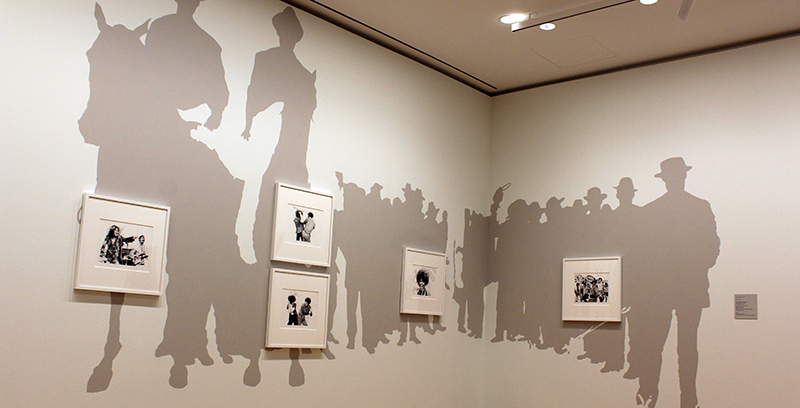
Photo by Debra Domal.
In I AM … THE NIGHT, Patrick Earl Hammie’s destabilizing conjunction of Soul Train images against a wall painted with silhouettes of a lynching mob challenges viewers to experience them in light of each other and in each other’s shadows. By exposing the cracks in the problematic tropes of Black entertainment, we are challenged to face the commodification of Black music and culture that clouds more innocent memories. Check out Hammie’s accompanying curated Spotify playlist here.
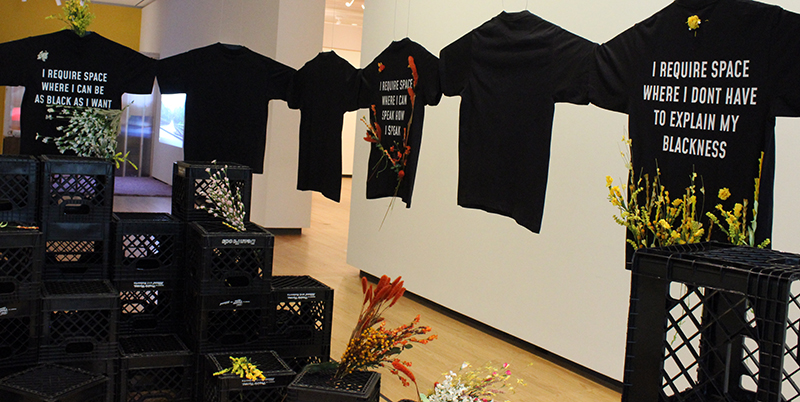
Photo by Debra Domal.
Nekita Thomas’ Black Space Protocols defines its space from the ground up with a large black tape square with each side defined by a single word: Manifesting. Politicking. Fortifying. Congregating. They map out what Black spaces can be. Within this space are those magical black milk crates set in a variety of configurations, some filled with flowers, evoking thoughts of beautification and memorialization. And atop them all, linked arm in arm, as if holding the line in protest and protection, are black t-shirts bearing the uncomfortable truths about being Black in largely white spaces.
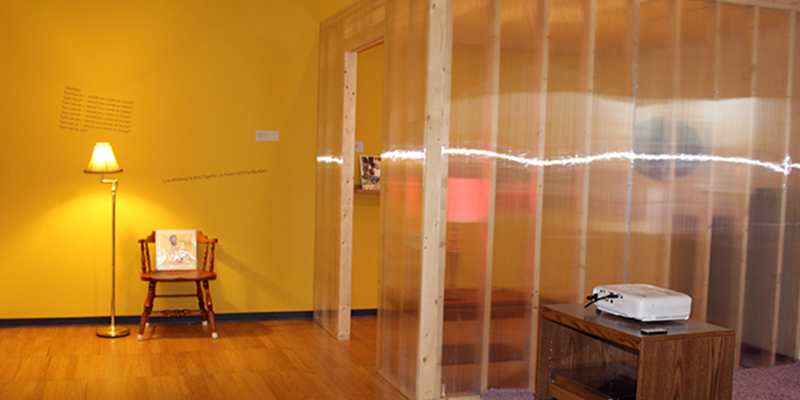
Photo by Debra Domal.
(Refrain) Turn Me On-Would You Come on Home?, curated by Blair Ebony Smith, who also curated the recent yearlong exhibition Homemade, with Love: More Living Room at KAM, manifests music’s power to transcend time and space. And while music is clearly a throughline across the entire exhibition — and throughout BQF and Afrofuturism — Smith’s soundscape illustrates the role of Black music in memory, legacy, and identity. Outfitted with both a sound booth and a living room-style listening space, (Refrain) emits a warm inviting glow, honoring the parts of the past we choose to carry with us into the present and the future.
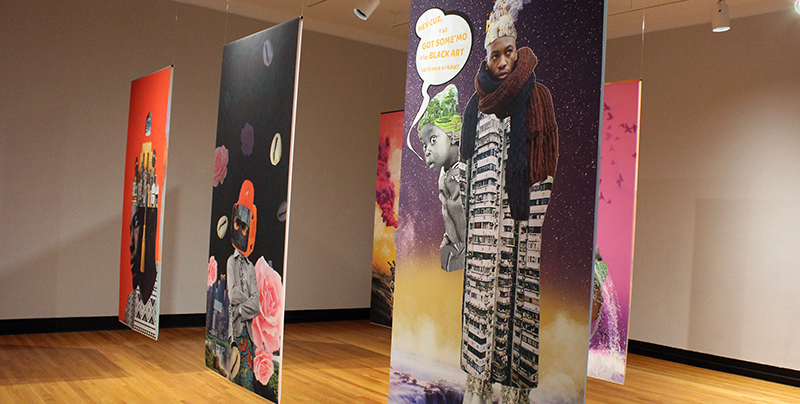
Photo by Debra Domal.
Black Audacious Freedom Dreams, curated by BLACKMAU (the dynamic duo of Stacey Robinson and Kamau Grantham,) uses digital collage aesthetics and hip-hop advertising strategies to create speculative Black futures filled with agency and freedom. Accompanied by a BLACKMAU video soundtrack, Black Audacious Freedom Dreams, like so much of BoBoBoB, is an interactive space and an invitation to dream. With key selections from the Ricker Library on the shelf and a fully connected workspace at the ready, the space is part exhibition and part laboratory/classroom. To see it filled with active and energized participants, as it was during the opening weekend and during the many tours and lecturers documented on Instagram, is to see it at its full power.
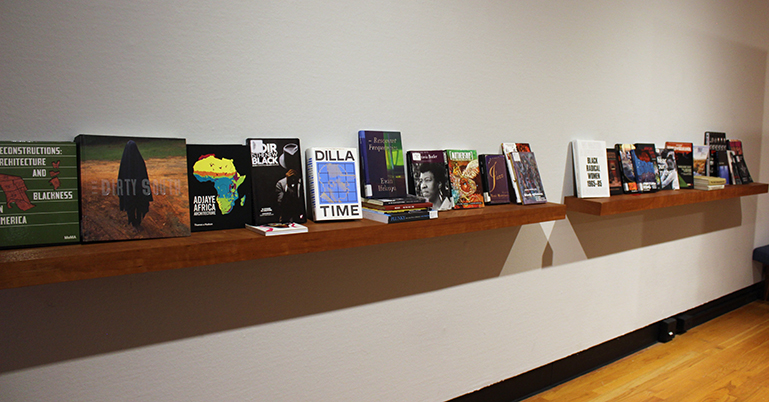
Photo by Debra Domal.
This is the space Stacey Robinson referred to when, at the end of the opening weekend panel discussion, a Black male graphic design student asked how and where he could find community. Robinson, along with the other three curators, encouraged him to claim this space, while offering access, mentorship, and resources. It seemed the perfect way to end; a problem had found its solution. But like many solutions it comes at a cost. This level of engagement, as inspiring and fitting as it seemed, represents just one example of the additional invisible, and often uncompensated, labor required by Black faculty members committed to bringing up the next generation. And while it is something that white faculty and students may learn, it is something they will never fully understand or experience. But that should not stop them from trying.
Similarly, white viewers may find Black on Black on Black on Black challenging, and, at times, uncomfortable. And that’s okay. But it shouldn’t stop them from experiencing it. During my most recent visit to the exhibition I encountered a significant number of white families. I was happy to see them there. Perhaps they continued their conversation about Black spaces on the way home. Or perthaps this experience checked off a box on their list of diverse experiences. One particular group I observed (and overheard) were fascinated by the precision of Patrick Earl Hammie’s painted wall silhouettes and the edge of the negative spaces in his Rorschach-like lynch mob astractions. This was their seed to carry with them. Perhaps under the right conditions it will grow. I believe that art such as this can meet us where we are, allow us to see and feel what we are ready to, encourage us to go deeper, and invite us to return.
Though BoBoBoB will leave KAM in early December, In Blackest Shade, In Darkest Light, an exhibition curated by and featuring the art of Patrick Earl Hammie, with Kumasi J. Barnett, William Downs, Kenyatta Forbes, Robert Pruitt, Stacey Robinson, and Charles Edward Williams, will take place at Parkland College’s Giertz Gallery from November 14th to February 18th, 2023. In addition, William Downs will present a lecture entitled Stories, Traveling, and Making Work at 6 p.m. on November 10th. Get more information here.
Black on Black on Black on Black
September 24-December 10
Krannert Art Museum
500 E Peabody
Champaign
T–Sa 10 a.m. to 4 p.m.








